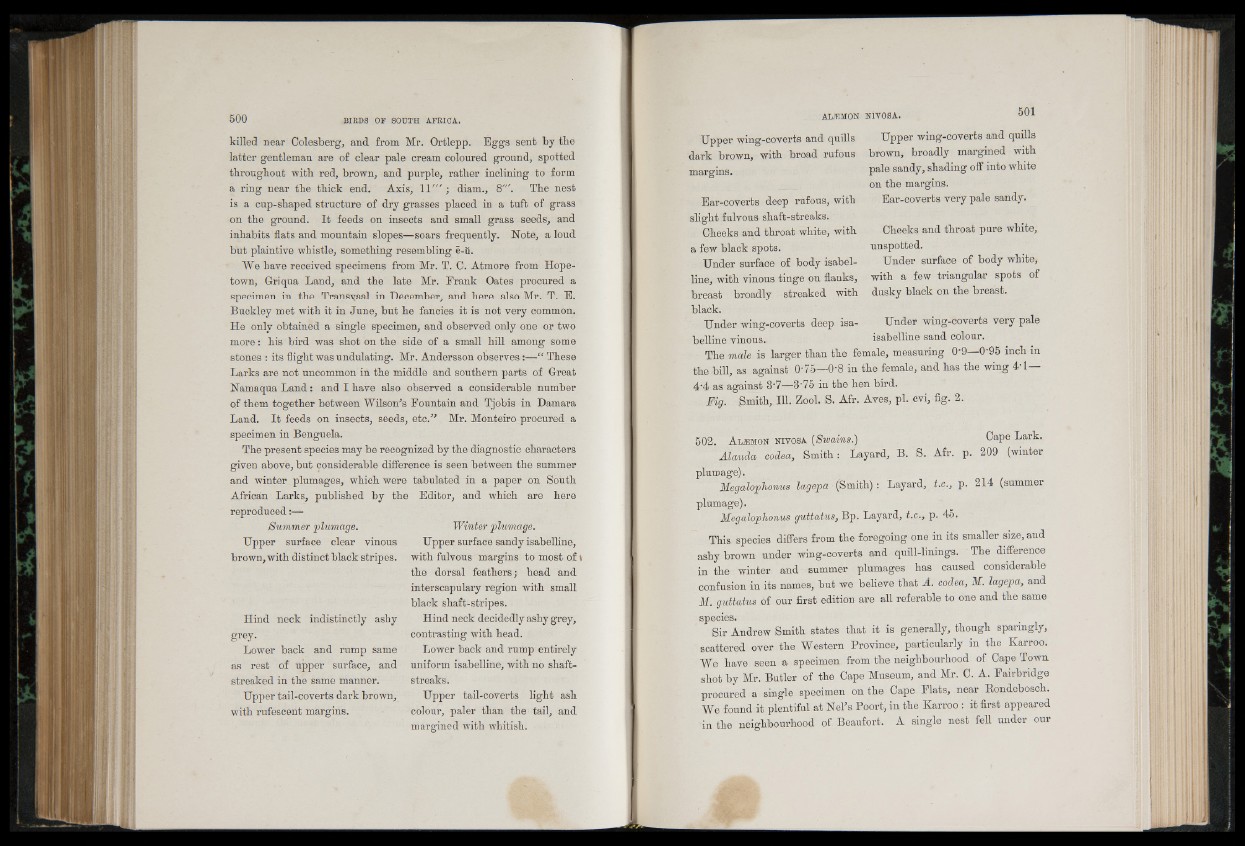
killed near Colesberg, and from Mr. Ortlepp. Eggs sent by the
latter gentleman are of clear pale cream coloured ground, spotted
throughout with red, brown, and purple, rather inclining to form
a ring near the thick end. Axis, 11/" ; diam., 8"'. The nest
is a cup-shaped structure of dry grasses placed in a tuft of grass
on the ground. It feeds on insects and small grass seeds, and
inhabits flats and mountain slopes—soars frequently. Note, a loud
but plaintive whistle, something resembling e-u.
We have received specimens from Mr. T. C. Atmore from Hope-
town, Griqua Land, and the late Mr. Prank Oates procured a
specimen in the Transyaal in December, and here also Mr. T. E.
Buckley met with it in June, but he fancies it is not very common.
He only obtained a single specimen, and observed only one or two
more: his bird was shot on the side of a small hill among some
stones : its flight was undulating. Mr. Andersson observes :—“ These
Larks are not uncommon in the middle and southern parts of Great
Namaqua Land: and I have also observed a considerable number
of them together between Wilson's Fountain and Tjobis in Damara
Land. It feeds on insects, seeds, etc.” Mr. Monteiro procured a
specimen in Benguela.
The present species may be recognized by the diagnostic characters
given above, but considerable difference is seen between the summer
and winter plumages, which were tabulated in a paper on South
African Larks, published by the Editor, and which are here
reproduced:—
Bummer plumage. Winter plumage.
Upper surface clear vinous Upper surface sandy isabelhne,
brown, with distinct black stripes, with fulvous margins to most of jthe
dorsal feathers; head and
interscapulary region with small
black shaft-stripes.
Hind neck indistinctly ashy Hind neck decidedly ashy grey,
grey. contrasting with head.
Lower back and rump same Lower back and rump entirely
as rest of upper surface, and uniform isabelline, with no shaftstreaked
in the same manner. streaks.
Upper tail-coverts dark brown, Upper tail-coverts light ash
with rufescent margins. colour, paler than the tail, and
margined with whitish.
Upper wing-coverts and quills Upper wing-coverts and quills
dark brown, with broad rufous brown, broadly margined with
margins. pale sandy, shading off into white
on the margins.
Ear-coverts deep rufous, with Ear-coverts very pale sandy.
slight fulvous shaft-streaks.
Cheeks and throat white, with Cheeks and throat pure white,
a few black spots. unspotted.
Under surface of body isabel- Under surface of body white,
line, with vinous tinge on flanks, with a few triangular spots of
breast broadly streaked with dusky black on the breast,
black.
Under wing-coverts deep isa- Under wing-coverts very pale
belline vinous. isabelline sand colour.
The male is larger than the female, measuring 0'9—0‘95 inch in
the bill, as against 0'75—0'8 in the female, and has the wing 4-1—
4*4 as against 3-7—3'75 in the hen bird.
Fig. .Smith, 111. Zool. S. Afr. Aves, pi. cvi, fig. 2.
502. A m m o n nivosa (Swains.) Cape Lark.
Alania codea, Smith: Layard, B. S. Afr. p. 209 (winter
plumage).
Megalophonus lagepa (Smith): Layard, i.e., p. 214 (summer
plumage).
Megalophonus guttatus, Bp. Layard, i.e., p. 45.
This species differs from the foregoing one in its smaller size, and
ashy brown under wing-coverts and quill-linings. The difference
in the winter and summer plumages has caused considerable
confusion in its names, but we believe that A. codea, M. lagepa, and
M. guttatus of our first edition are all referable to one and the same
species.
Sir Andrew Smith states that it is generally, though sparingly,
scattered over the Western Province, particularly in the Karroo.
We have seen a specimen from the neighbourhood of Cape Town
shot by Mr. Butler of the Cape Museum, and Mr. C. A. Fairbndge
procured a single specimen on the Cape Flats, near Bondebosch.
We found it plentiful at Nel's Poort, in the Karroo : it first appeared
in the neighbourhood of Beaufort. A single nest fell under our